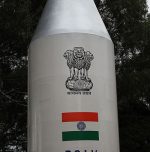ISRO launches heaviest satellite from Indian soil yesterday

India’s space program is set to make history today as ISRO prepares to launch its heaviest satellite using an indigenous rocket.
The LVM3-M5, also known as Bahubali, will carry the 4,410 kg CMS-03 communication satellite into a Geosynchronous Transfer Orbit (GTO).
This marks the first time such a heavy satellite will be launched from Indian soil using a home-built rocket.
Earlier, ISRO’s heaviest satellite, GSAT-11, weighing 5,854 kg, was launched on December 5, 2018, from French Guiana aboard the Ariane-5 VA-246 rocket.
The 43.5-metre-tall LVM3-M5 has been fully assembled and integrated with the spacecraft.
Moreover, it has been moved to the second launch pad for pre-launch operations.
On Saturday, ISRO confirmed on social media that the liftoff is scheduled for 5:26 p.m yesterday.
LVM3, or Launch Vehicle Mark-3, is ISRO’s heavy-lift rocket designed to place 4,000 kg-class satellites in GTO.
It offers a cost-effective and reliable launch option for communication satellites.
The CMS-03 is a multi-band communication satellite that will deliver services across India and nearby oceanic regions.
The three-stage vehicle consists of two large solid strap-on boosters (S200), a liquid core stage (L110), and a cryogenic upper stage (C25). These stages provide high thrust and precision during flight.
The S200 boosters, developed at the Vikram Sarabhai Space Centre in Thiruvananthapuram, generate the power needed for liftoff.
The L110 stage, powered by twin Vikas engines, was designed at the Liquid Propulsion Systems Centre.
This mission marks the fifth operational flight of the LVM3 series. Notably, the rocket’s previous success was the Chandrayaan-3 mission, which made India the first nation to land near the lunar south pole in 2023.
With this mission, ISRO reinforces India’s growing strength in heavy satellite launches.
Furthermore, it underlines the nation’s capability to achieve space self-reliance without foreign support, an achievement that continues to inspire scientific pride and global admiration.
Image Credit: Anmollshrma, CC0 1.0, via Wikimedia Commons
Image Reference: https://commons.wikimedia.org/wiki/File:Isro_headquarters.jpg








Leave a Reply